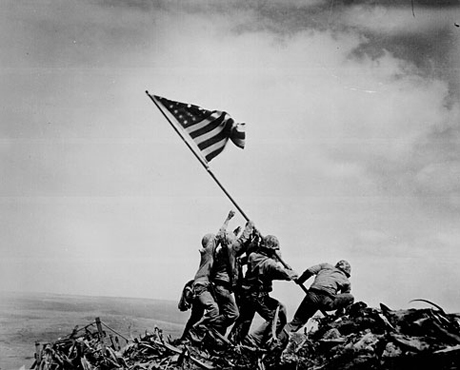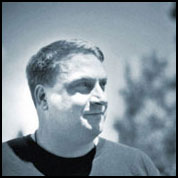« Gridiron Gang (2006) – Movie Review | Home | It’s a Wonderful Life (1946) – Movie Review »
Flags of Our Fathers (2006) – Movie Review
By Robert L. Jones | October 21, 2006

Joe Rosenthal's immortal photo of the second Iwo Jima flag raising in 1945
Almost Desecration
[xrr rating=3/5]
Flags of Our Fathers. Starring Ryan Phillippe, Jesse Bradford, Adam Beach, John Benjamin Hickey, John Slattery, Barry Pepper, Jamie Bell, Paul Walker, Robert Patrick, Neal McDonough, Melanie Lynskey. Screenplay by William Broyles, Jr., and Paul Haggis. Based on the book by James Bradley with Ron Powers. Directed by Clint Eastwood. (Warner Bros., DreamWorks Pictures, 2006, color, 132 minutes. MPAA rating: R
Clint Eastwood is arguably our greatest living motion picture director. Thirty-five years after his directorial debut in the Hitchcock homage Play Misty for Me (1971), the silent, gritty actor who learned his filmmaking craft at the feet of such masters as Sergio Leone and Don Siegel has produced a body of work sweeping in variety of subject matter, yet singular in its artistic vision. While many of his contemporaries have slipped in critical esteem—most notably Francis Ford Coppola and Martin Scorsese—the two-time Oscar-winning director of Million Dollar Baby (2004) and Unforgiven (1992) has only improved with age.
Until now. In his latest cinematic offering, Eastwood misses the mark with this loose, relentlessly dark, and ultimately cynical adaptation of James Bradley’s book of the same name.
The book was a tribute to the six Marines (one of them his father, John “Doc” Bradley) who raised Old Glory atop Mount Suribachi on the Japanese volcanic island of Iwo Jima, on February 23, 1945. Bradley’s work chronicles the life stories of these six—three who survived the carnage that claimed almost 7,000 American lives: John Bradley, Ira Hayes, and Rene Gagnon; plus the three who perished: Franklin Sousley, Harlon Block, and Mike Strank. Of the survivors, none considered himself heroic for raising the flag or even for his deeds in combat. John Bradley shunned talk about the war, and it was only after his passing that son James found a shoebox in the family’s attic containing mementos, most notably a Navy Cross. “Doc” Bradley, a corpsman (Navy lingo for “medic”), had resuscitated a wounded Marine during a fierce firefight while his own body was ripped by Japanese shrapnel. Yet it was not for bravery that Bradley and his comrades were immortalized after the war, but rather for their chance appearance in Associated Press photographer Joe Rosenthal’s iconic image—perhaps the most recognizable photograph in history, taken on the fifth day of the bloodiest battle of World War II.
Their individual achievements, identity, and dignity eventually became subsumed in the aura of the legend created by “The Photo.” Through their stories, Bradley’s exhaustively researched book gently prods the reader to consider the true nature of heroism. He pens a moving historical account, shedding light on the real lives of six individuals who rose to greatness despite their flaws and despite history’s tendency to transform them into anonymous symbols of heroic virtue.
It’s a powerful message which, sadly, gets mangled in Eastwood’s overreaching screen adaptation. Although many of the elements of Bradley’s account make it onscreen, in Eastwood’s hands Flags of Our Fathers becomes a documelodrama—a ghastly tragedy that subverts the humanity of Bradley’s account, becoming an overwrought portrait of the three surviving flag-raisers as victims.
To be sure, an interesting portrait it is—a story that promises to grab you by the heart and never let go. After Rosenthal’s photo blazes across the front pages of America’s newspapers, Bradley, Gagnon, and Hayes are whisked up by a cynical public relations machine to shill war bonds to a war-weary America. Though taking up only sixteen of the book’s 382 pages, the war bond drive comprises the bulk of the film’s plot and onscreen action.
The book treats the “Mighty 7th” War Loan bond drive ambivalently, though mostly positively. The drive raised over $26.3 billion from American individuals, families, and businesses—almost half of the 1946 fiscal year federal budget of $56 billion—thus making it possible to rearm the military to force Japan’s defeat in the war’s final months. “When I spoke with a Treasury Department source by telephone to confirm these figures,” Bradley writes, “the official marveled over the size and accomplishments of the Mighty 7th. He fell silent for a moment as he shuffled some papers on his desk. Then he said, simply: ‘We were one then.’” Indeed, without victory at Iwo Jima and the funds raised by the bond drive, the second most recognizable WWII photo—Alfred Eisenstaedt’s August 15, 1945 shot of a returning sailor planting a big, juicy kiss on a nurse in Times Square on VJ Day—might never have been taken.
But Eastwood fixates on the bond drive, taking its highs and lows to distill a potent concoction of pure misery. His account depicts the men’s whirlwind, whistle-stop tour of America’s metropolises as a slick, gaudy sideshow run by contemptuous PR men. It’s a chronicle of exploiting the flag-raisers by having them climb atop a papier-mâché Mount Suribachi to raise the red, white, and blue—of tastelessly serving ice cream molded in the shape of the raising—of glad-handing businessmen and politicians who seek to use the men for their own profit.
Marine Private Ira Hayes becomes the movie’s conscience during all the ballyhoo. “I think this whole goddamn thing is a farce, if you ask me,” he mutters. Yet the book version gives little such evidence of Hayes’s revulsion. In one scene from the book, a politician introduces Hayes (a Pima American Indian) as “the only man here who can claim to be a real American.” In the film version, actor Adam Beach reacts mostly silently and stoically. Perhaps Eastwood felt that Hayes’s reaction in real life, in which he strode up to the microphone and exclaimed, “I’m an Indian and I’m damn proud of it,” would have undermined his effort to portray Hayes as a hapless victim of constant racial slurs.
The look and feel of the movie also serve to evince Eastwood’s dark artistic agenda. A pall of foreboding darkness permeates not only the grueling battle scenes but even the movie’s happier moments (e.g., coming back home to family, or Bradley marrying his childhood sweetheart), rendering them at best bittersweet. Director of photography Tom Stern filmed Flags of Our Fathers almost monochromatically, in swathes of rich cobalt blue, muting the other hues of the spectrum in the color timing.
The movie’s chief flaw is in its confused narrative structure, told mostly by overusing flashbacks. Eastwood and editor Joel Cox used flashback montages to great effect in 1995’s The Bridges of Madison County, but they don’t quite pull it off here. As a viewer, I felt like a ping-pong ball paddled between the bond rallies and the battle scenes; by the middle of the film, I could already anticipate that a newspaper photographer’s blinding flashbulb at a stadium appearance would cut right to a nighttime flare or exploding ordnance as one of the three soldiers relived the hell of war.
Although Eastwood captures the gory reality of the battle scenes, he never offers the viewer the reason for capturing Iwo Jima, or details of the genuinely heroic exploits of the twenty-two Marines and five sailors who were awarded the Congressional Medal of Honor (the most given in any single battle in the history of American warfare). Furthermore, even after more than two hours, the viewer never really gets to know as individuals Bradley (Ryan Phillippe) or Gagnon (Jesse Bradford), not to mention the three flag-raisers who died.
The only thing that resonated with me at all was Adam Beach’s moving performance as Ira Hayes. It’s a tragic story of alcoholic despair and guilt that so many fellow Marines died while he was spared, ending with his loss of dignity and untimely death. Yet Hayes’s story is poignant only as a vignette within an otherwise two-dimensional film and deserved fuller development, along the lines of Eastwood’s biopic of saxophonist Charlie Parker, Bird (1988).
James Bradley closes his book by conveying great respect for his father’s modest request to posterity:
After spending five years researching their lives, the boys certainly seem like heroes to me. I admit it.But I must defer to my father…. I will take my dad’s word for it: Mike, Harlon, Franklin, Ira, Rene, and Doc, the men of Easy Company—they just did what anybody would have done, and they were not heroes
Not heroes.
They were boys of common virtue. Called to duty. Brothers and sons. Friends and neighbors. And fathers. It’s as simple as that.
Anyone who had a friend or loved one who fought in World War II recognizes this modesty as a hallmark of that generation. My adopted godfather, Nick, a crusty old Marine who served in Guadalcanal, told me a thousand war stories, most of which involved goofing off with dames and alcohol, hitching rides back home on furlough, reminiscing about buddies who never made it back, playing practical jokes on each other. He never spoke about combat, though.
Nick was a real-life hero to me. I have no idea what he did to earn a chestful of ribbons, and I never asked him, because I figured that if he ever wanted me to know, he’d tell me. But he never did. And it never really mattered, because I learned from him that real heroes don’t blow their own horn.
Eastwood’s version of their story is ultimately a deconstruction of their heroism. He basically writes off the heroic with a relativistic cliché—“Everyone likes things nice and simple—good and evil, heroes and villains”—and ends with a bitter lament: “Maybe there is no such thing as heroes.” Even Sergeant Sefton, Billy Wilder’s cynic extraordinaire in the 1953 film Stalag 17, could become the hero with a heart of gold; but in Flags of Our Fathers, Eastwood performs a sort of reverse alchemy, chucking out gold nuggets while panning for mud.
If Eastwood’s aspirations were merely artistic, I’d regard Flags of Our Fathersas a flawed classic. But it’s worse than that, because he has an agenda. He subverts the truth of these individuals’ stories to craft a political message of exploitation. In doing so, Eastwood transforms Bradley, Gagnon, and Hayes into a sotto voce symbolic rebuke for the “Mission Accomplished” banner aboard the U.S.S. Lincoln aircraft carrier in 2003, when former Texas Air National Guard fighter pilot and current president George W. Bush co-piloted a Navy SB-3 Viking to mark victory in the Iraq war. Sure, I thought Bush was undignified in doing that, because although he had never served in combat a day in his life, he cast himself as some kind of returning war hero. The credit for that victory rightfully should have gone to those brave warriors who actually stood in harm’s way.
That said, I found it highly ironic that despite Eastwood’s strident crowing against the (mostly imaginary) exploitation of Bradley, Gagnon, and Hayes, he himself, having an ideological axe to grind, would exploit and trivialize these heroes over sixty years later.
Unlike in Unforgiven, there is neither riveting drama nor stellar acting (with the exception of Beach) evident in Flags of Our Fathers to allow it to withstand the test of time. By belittling the heroism of its subjects, this flick will more than likely be regarded as one of Clint Eastwood’s minor works, alongside movies like Blood Work (2002) and True Crime (1999).
Robert L. Jones is a photojournalist living and working in Minnesota. His work has appeared in Black & White Magazine, Entrepreneur, Hoy! New York, the New York Post, RCA Victor (Japan), Scene in San Antonio, Spirit Magazine (Canada), Top Producer, and the Trenton Times. Mr. Jones is a past entertainment editor of The New Individualist.
Topics: Docudramas, Dramas, Movie Reviews, War Movies | Comments Off on Flags of Our Fathers (2006) – Movie Review
